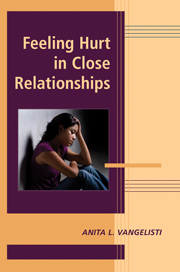Book contents
- Frontmatter
- Contents
- List of Contributors
- Foreword
- PART I INTRODUCTION
- PART II CONCEPTUALIZING HURT
- 2 The Nature of Hurt Feelings: Emotional Experience and Cognitive Appraisals
- 3 Thinking the Unthinkable: Cognitive Appraisals and Hurt Feelings
- 4 Adding Insult to Injury: The Contributions of Politeness Theory to Understanding Hurt Feelings in Close Relationships
- 5 Rejection Sensitivity: A Model of How Individual Difference Factors Affect the Experience of Hurt Feelings in Conflict and Support
- 6 Understanding and Altering Hurt Feelings: An Attachment-Theoretical Perspective on the Generation and Regulation of Emotions
- PART III HURTFUL ACTS
- PART IV HURT IN RELATIONAL CONTEXTS
- PART V HURT IN APPLIED CONTEXTS
- Author Index
- Subject Index
- References
3 - Thinking the Unthinkable: Cognitive Appraisals and Hurt Feelings
from PART II - CONCEPTUALIZING HURT
Published online by Cambridge University Press: 04 August 2010
- Frontmatter
- Contents
- List of Contributors
- Foreword
- PART I INTRODUCTION
- PART II CONCEPTUALIZING HURT
- 2 The Nature of Hurt Feelings: Emotional Experience and Cognitive Appraisals
- 3 Thinking the Unthinkable: Cognitive Appraisals and Hurt Feelings
- 4 Adding Insult to Injury: The Contributions of Politeness Theory to Understanding Hurt Feelings in Close Relationships
- 5 Rejection Sensitivity: A Model of How Individual Difference Factors Affect the Experience of Hurt Feelings in Conflict and Support
- 6 Understanding and Altering Hurt Feelings: An Attachment-Theoretical Perspective on the Generation and Regulation of Emotions
- PART III HURTFUL ACTS
- PART IV HURT IN RELATIONAL CONTEXTS
- PART V HURT IN APPLIED CONTEXTS
- Author Index
- Subject Index
- References
Summary
INTRODUCTION
“A man is hurt not so much by what happens to him as by his opinion of what happens.”
Montaigne, 16th centuryAs a rule, human beings neither seek nor enjoy the experience of pain. By definition, pain involves suffering, and given the choice, we would rather go through life without it. Fortunately, we have no such choice – fortunately, because pain is critical to our survival. Without the felt experience of pain, we would fail to notice injuries. Only the smell of burning flesh would alert us to the fact that we were on fire, and we would have no inkling that our leg was shattered until we noticed that walking was difficult. Pain, then, is adaptive and helps keep us alive. However, pain is not just a physical phenomenon; it is also psychological. Experiences of heartache and loneliness involve psychological suffering, and this too is adaptive. As social creatures, humans are dependent on their relationships with others – in particular, parents, siblings, partners, and friends – for their survival. Just as physical pain alerts individuals to physical harm, so too does psychological pain alert them to social harm such as rejection or abandonment (MacDonald & Leary, 2005). The pain of appendicitis and the pain of social loss, then, serve similar functions: they let us know we are in trouble, they motivate us to cry out in protest, and they motivate others to come to our aid.
- Type
- Chapter
- Information
- Feeling Hurt in Close Relationships , pp. 34 - 49Publisher: Cambridge University PressPrint publication year: 2009
References
- 9
- Cited by



